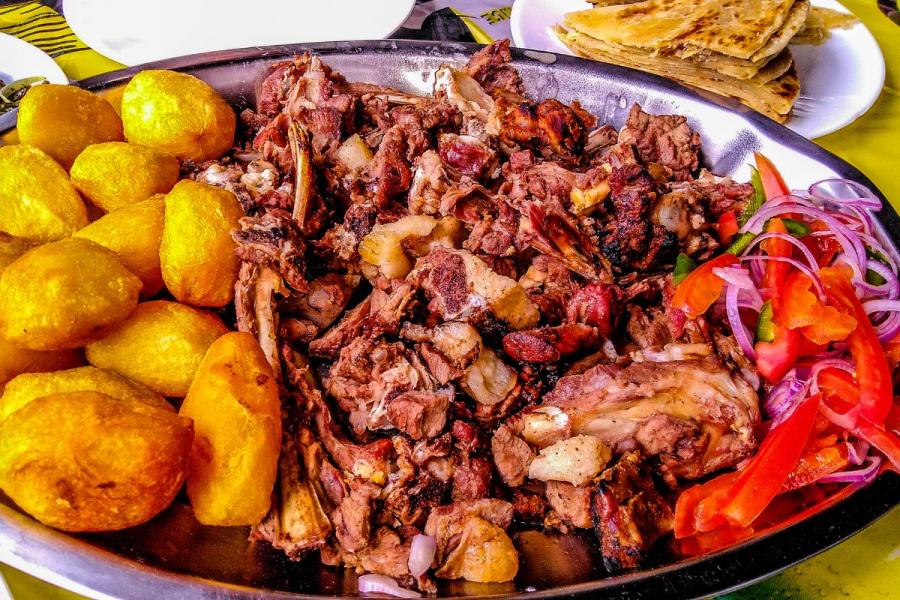Food in Tanzania
Food culture and cuisine in Tanzania
The food culture in Tanzania is a vibrant tapestry woven from the diverse ethnic communities, historical influences, and the bountiful resources of the land and sea.
Tanzania, a country with a rich cultural heritage and a diverse landscape, offers a unique and vibrant food scene that reflects its history, geography, and the various cultures that have influenced it over the years. From the bustling streets of Dar es Salaam to the serene beaches of Zanzibar, Tanzanian cuisine is a delightful exploration of flavors, ingredients, and cooking techniques that are sure to captivate any food lover's heart.
Tanzanian foods
Although only a small portion of its land is sutiable to grow crops, Tanzania's agriculture is diverse, thanks to its varied climates and landscapes.
Maize and rice: Foundation of many meals.
Cassava and sweet potatoes: Widely grown and consumed.
Beans, peas, and lentils: Essential sources of protein.
Fruits and vegetables: Mangoes, oranges, bananas, tomatoes, and leafy greens are abundant.
Spices: Cloves, cinnamon, and cardamom from Zanzibar, the "Spice Island."
Food processing is the main industry in the country.
Staple foods and ingredients
Tanzanian cuisine is characterized by the use of simple, fresh ingredients that are often produced locally. The staple food for most Tanzanians is ugali, a stiff dough made from maize flour, which is typically served with meat, fish, vegetables, or beans. Another essential component of the Tanzanian diet is rice, which is frequently prepared with spices and coconut milk, especially in coastal areas, giving it a distinctive, flavorful twist.
Beans, lentils, and legumes are widely consumed and are important sources of protein in the Tanzanian diet. These are often cooked in a variety of ways, sometimes with coconut milk or mixed with vegetables.
The use of fresh vegetables like spinach, okra, and tomatoes is prevalent in many dishes, reflecting the country's rich agricultural resources. Fruits such as mangoes, pineapples, bananas, and avocados are abundant and consumed regularly, either as snacks or as part of meals.
Meat (especially beef, chicken, and goat) and fish (from the country's lakes and coastal regions) are also integral to Tanzanian cuisine, though they may be eaten less frequently due to their higher cost.
Cooking methods and traditional dishes
Tanzanian cuisine is a blend of native African cooking traditions with influences from Arab, Portuguese, Indian, and British colonizers. The introduction of spices, coconut, and techniques like grilling and curry-making have enriched the local cuisine, making it a unique fusion of flavors.
Tanzanian cooking methods are often straightforward but effective in bringing out the natural flavors of the ingredients. Grilling, boiling, and stewing are common techniques, with many dishes simmered to perfection over wood fires or charcoal stoves.
Tanzanian cuisine is colse to that of Kenya.
Daily meals and eating habits
Breakfast (kifungua kinywa): Often light, including tea or coffee with bread, chapati, or mandazi (Swahili doughnuts).
Lunch (chakula cha mchana): The main meal of the day, typically featuring a starch (ugali, rice, or chapati) with a meat, fish, or vegetable sauce.
Dinner (chakula cha jioni): Similar to lunch but might be lighter, often eaten late in the evening.
Iconic dishes
Nyama choma (grilled meat) is a popular dish, especially as a social food, often enjoyed with friends and family at gatherings. Beef, chicken, or goat, marinated in spices, are grilled.
Ugali: A stiff dough made from maize flour, a staple accompaniment to meals.
Mchuzi (a type of curry) is widely loved, made with meat or fish and a blend of spices, showcasing the Indian influence on Tanzanian cuisine. Mchuzi wa samaki is a fish curry, reflecting the coastal communities' reliance on the Indian Ocean.
Chapati, influenced by the Indian subcontinent, is a type of flatbread that is a favorite accompaniment to many meals. Spiced rice dishes influenced by Indian cuisine, such as pilaus and biryanis, are also popular in coastal regions.
Samaki wa kupaka, a coastal delicacy, involves fish marinated in spices and coconut milk before being grilled.
Zanzibar pizza, a street food favorite, is a unique take on pizza, filled with meat, vegetables, and sometimes egg, showcasing the blend of cultures in Tanzanian cuisine.
Street food also plays a significant role in Tanzanian food culture, with vendors offering a variety of snacks and dishes that reflect the country's culinary diversity. From maandazi (Swahili doughnuts) to mishkaki (skewered and grilled meat), the streets of Tanzania are a food lover's paradise.
Popular drinks
Chai: Tea is a popular beverage, often spiced with cardamom, cinnamon, or ginger.
Coffee: Tanzania is a significant coffee producer, and locally brewed coffee is a must-try.
Konyagi: A local gin-like spirit that is widely consumed.
Fresh juices: Made from the abundant fruits, including passion fruit, mango, and orange.
Food culture and practices
Food in Tanzania is more than just sustenance; it is a way of life and a means of bringing people together. Meals are typically communal, with families and friends gathering to share food from a common plate, reflecting the country's emphasis on community and togetherness.
Tanzanian cuisine offers a fascinating glimpse into the country's cultural heritage, agricultural bounty, and the daily lives of its people. From the staple ugali to the exotic spices of Zanzibar, the food culture in Tanzania is a rich, flavorful journey worth exploring.

